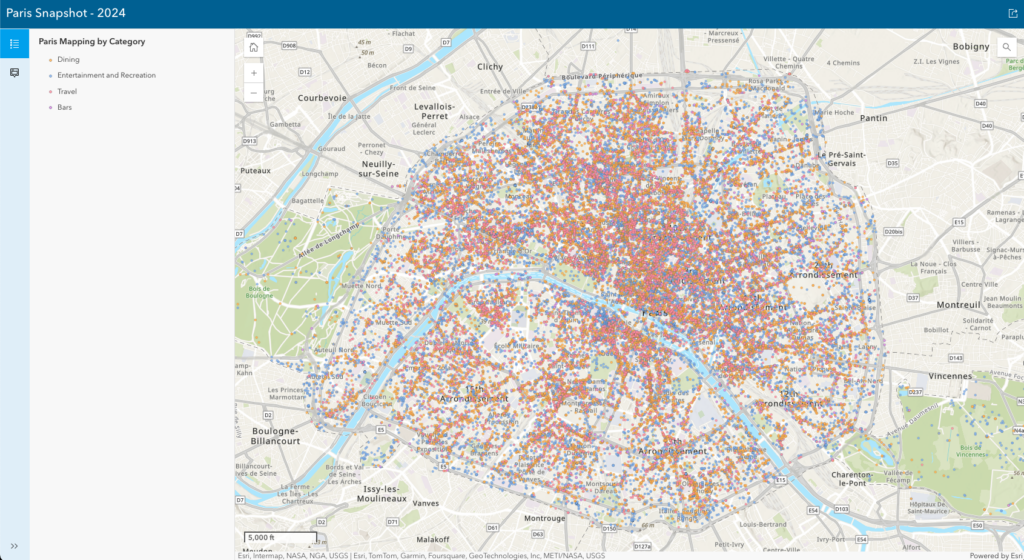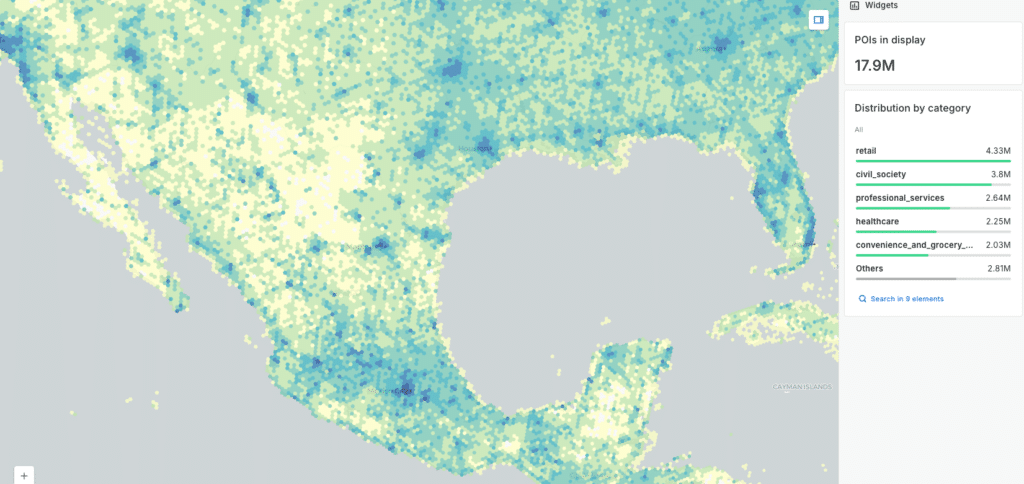
Harnessing Location Data: Unlocking New Frontiers for Global Growth
Harnessing Location Data: Unlocking New Frontiers for Global Growth
In today’s environment, location data plays a pivotal role in shaping industry strategies and driving decision-making. By leveraging location data, companies can uncover new opportunities, streamline operations, and rapidly navigate complex global markets.
Location data is critical not only for chief data officers, geospatial data scientists, and global growth officers, but also for a wide range of professionals across various industries. According to a MarketsandMarkets report, the global location analytics market is projected to grow from $20.6 billion in 2023 to $38.5 billion by 2028, driven by the increasing adoption of location intelligence among leading Fortune 500 companies.
In this article, we will examine the role of location data in business strategy, the rising significance of this data among industry leaders, and how top companies are leveraging our services to unlock new markets for global growth.
What is Location Data?
Location data is geographic information that pinpoints the physical location of a place, person, or object on earth. It can help businesses decide where to expand, optimize operations, or target specific markets.
Location-based data is gathered through multiple methods and incorporates a range of metrics: machine learning, advanced image recognition, artificial intelligence, large language models, and global human validators.
With dataplor, businesses can get the spatial data they need to drive their strategic decision-making.
Tools and Technologies for Visualizing Location Data
Managing and analyzing location data requires advanced spatial analytics tools and Geographic Information Systems (GIS). These tools are designed to process vast amounts of geographic data, transforming raw data into actionable insights that strengthen business decisions.Spatial analytics tools like Esri and CARTO are well known for their capabilities in location data visualization.

Source: Esri
Caption: The above is a visual representation of dataplor’s data on Esri’s platform.
Esri’s ArcGIS offers an entire suite of tools for location information, mapping, spatial analysis and data visualization. Businesses can integrate multiple data sources, analyze geographic trends and points of interest (POI), and make real-world decisions based on spatial patterns.

Source: CARTO
Caption: The above is a visual representation of dataplor’s data on CARTO’s platform.
CARTO offers robust location intelligence solutions that enable users to visualize and analyze spatial data effortlessly. Their cloud-based platform supports real-time data processing, making it ideal for businesses that require up-to-date insights.
Applications Across Industries
Location intelligence is a powerful asset across many industries, offering a range of use cases.
From retail to telecommunications, companies leverage this data to gain a competitive edge, make informed decisions, and unlock new opportunities. Here’s how various sectors use different types of location data to achieve success.
Retail
For retailers, location data is key to site selection. By analyzing demographic and geographic data, companies can identify prime locations for new stores that maximize profitability and effectively reach their target audience.
For example, by understanding their local competition, retailers can position themselves in high-demand areas to outpace their competitors and increase revenue.
Third-Party Logistics (3PL)
In third-party logistics, location data can help optimize route planning and delivery times. Companies like Uber use this data to streamline last-mile fulfillment, ensure on-time deliveries, and reduce operational costs.
Accurate location data allows logistics providers to plan the most efficient routes, reduce fuel consumption, and improve overall service levels while boosting revenue.
Real Estate
Real estate companies use location data to make better investment decisions. By analyzing property values, surrounding amenities, and future development plans, they can find high-potential areas to invest in.
This data also helps assess a location’s risk factors so companies can make informed decisions that yield long-term returns.
Telecommunications
Location data is key to network expansion and optimization in the telecom industry. Companies use this data to find areas of high demand for services, allowing them to reach new audiences and provide coverage.
By analyzing geographic trends, these companies can place cell towers and other infrastructure in the right places to maximize service quality and customer satisfaction.
Enhancing Business Operations and Customer Experience
Location data is key to business operations and customer experience. By using this data, companies can refine processes, better target customers, and gain a competitive edge.
Here’s how:
- Improving Business Operations: One major advantage of location data is its ability to optimize supply chains. Businesses can use this data to identify the most efficient delivery routes, helping to cut down on both delivery times and costs. For example, a company can analyze geographic constraints to ensure timely deliveries and minimize disruptions. This level of precision in supply chain management means better resource allocation and higher operational efficiency.
- Competitive Intelligence: In today’s competitive landscape, understanding where your competitors operate and how they perform is essential. Location data gives insights into competitor activity, helping businesses identify market gaps and capitalize on them. By analyzing the locations of competing stores, companies can strategically position themselves in underserved areas, capture market share, and attract new customers.
- Operational Enhancements and Customer Experience: The advantages of location data extend beyond internal operations. Ride-sharing companies like Uber use location data to optimize driver routes, ensuring timely and efficient service for customers. Similarly, food delivery services use this data to connect customers with nearby restaurants, resulting in quicker deliveries and a better dining experience.
Challenges and Solutions in Location Data Usage
As businesses opt in and rely on location data for decision making, they face several challenges that can impact the quality and reliability of the data. Understanding and addressing these challenges is key to using location data successfully.
Data Accuracy
One of the biggest challenges with location data is ensuring accuracy. Inaccurate or out-of-date data can lead to bad decisions and costly mistakes.
While open source data such as OpenStreetMap (OSM) is attractive due to its low cost, the quality can vary significantly. This can result in issues like fabricated or wrong points of interest, missing data points, and outdated information.
These inaccuracies can derail your business strategy, making reliable data essential for any organization.
Privacy
With more companies using location data, concerns around data privacy are growing. Organizations must navigate complex regulations and ethical considerations to ensure that the data they use respects individuals’ privacy rights.
This means implementing robust data governance and adhering to GDPR regulations, which dictate how location data is collected, stored, and used.
Integration Complexity
Integrating location data from multiple sources is a big challenge. Different data sets can use different formats, schemas, and standards, so combining and analyzing the data is challenging. This complexity prevents organizations from getting a complete view of their operations and market.
OSM Data vs. Paid Data
Open source data sources like OSM offer but often lack consistency and timeliness. If you buy location data from dataplor, these challenges are solved. Paid data providers ensure accuracy, quality, and up-to-date information through advanced technology and rigorous quality control measures.
For example, dataplor’s proprietary machine learning algorithms and human validation processes ensure that the data is precise, current, and reliable.
How dataplor Solves These Challenges
dataplor offers real-time, globally scaled location data that solves businesses’ biggest challenges. The data we provide is accurate, current, and validated by local experts to meet the highest standards.
By combining technology with human expertise, dataplor provides a robust solution that helps organizations overcome the challenges of using location data to confidently make informed data-driven decisions.
Fuel Data-Driven Decision Making with dataplor
When used effectively, location datasets can unlock new opportunities, optimize operations, and drive long-term growth.
Using accurate, real-time location data, companies can make informed decisions that improve customer experiences, streamline logistics, and get ahead of the competition. Integrating location data into your business can offer significant advantages, from finding the best retail locations to optimizing supply chains.
Working with dataplor gives you location intelligence solutions tailored to your needs. With a focus on data accuracy and quality, dataplor provides your business with the necessary tools to navigate complex markets and make impactful decisions
Contact us to learn more or request a sample today.
Let’s get started.


